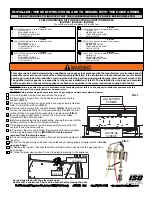
34
Regency Bellavista™ B36X Gas Fireplace
GAS LINE
INSTALLATION
The gas line is brought through the right side
of the appliance. The gas valve is situated on
the right hand side of the unit and the gas inlet
is on the right hand side of the valve.
The gas line connection may be made of
rigid pipe, copper pipe or an approved
fl
ex
connector. (If you are using rigid pipe, ensure
that the valve can be removed for servicing.)
Since some municipalities have additional
local codes it is always best to consult with
your local authorities and the CAN/CGA B149
installation code.
For USA installations follow local codes and/
or the current National Fuel Gas Code, ANSI
Z223.1.
When using copper or
fl
ex connectors use only
approved
fi
ttings. Always provide a union so
that gas lines can be easily disconnected for
servicing. Flare nuts for copper lines and
fl
ex
connectors are usually considered to meet
this requirement.
Important: Always check for gas leaks
with a soap and water solution or gas leak
detector. Do not use open
fl
ame for leak
testing.
Diagram 4
Diagram 3: The upper half of the
fl
ashing is
installed under the roo
fi
ng material and not
nailed down until the chimney is installed.
This allows for small adjustments.
Diagram 2
UNIT INSTALLATION
WITH VERTICAL
TERMINATION
(
MUST USE REDUCER
# 946-606 AND RIGID PIPE ADAPTOR
#770-994)
1)
Maintain the 1-1/2" clearances
(air spaces) to combustibles
when passing through ceilings,
walls, roofs, enclosures,
attic rafter, or other nearby
combustible surfaces. Do not
pack air spaces with insulation.
Check "Venting" Sections for
the maximum vertical rise of
the venting system and the
maximum horizontal offset
limitations.
2)
Set the gas appliance in
its desired location. Drop
a plumb bob down from
the ceiling to the position
of the appliance
fl
ue exit, and mark the
location where the vent will penetrate the
ceiling. Drill a small hole at this point. Next,
drop a plumb bob from the roof to the hole
previously drilled in the ceiling, and mark
the spot where the vent will penetrate the
roof.
3)
A Firestop spacer must be installed in the
fl
oor or ceiling of every level. To install the
Firestop spacer in a
fl
at ceiling or wall,
cut a 10 inch square hole. Frame the hole
as shown in Diagram 2 and install the
fi
restop.
NOTE:
For best results and optimum
performance with each approved venting
system, it is highly recommended to apply
“Mill-Pac” sealant (supplied) to every in-
ner pipe connection. Failure to do so may
result in drafting or performance issues not
covered under warranty. Silicone (red RTV)
is optional.
4)
Assemble the desired lengths of pipe and
elbows. Ensure that all pipes and elbow
connections are in the fully twist-locked
position and sealed.
5)
Cut a hole in the roof centered on the small
drilled hole placed in the roof in Step 2. The
hole should be of suf
fi
cient size to meet
the minimum requirements for clearance
to combustibles of 1-1/2". Slip the
fl
ashing
under the shingles (shingles should overlap
half the
fl
ashing) as per Diagram 3.
6)
Continue to assemble pipe lengths.
Note: If an offset is necessary in the attic to
avoid obstructions, it is important to
support the vent pipe every 3 feet, to
avoid excessive stress on the elbows,
and possible separation. Wall straps
are available for this purpose.
Galvanized pipe is desirable above the roo
fl
ine
due to its higher corrosion resistance. Continue
to add pipe sections through the
fl
ashing until
the height of the vent cap meets the minimum
height requirements speci
fi
ed in Dia. 4 or local
codes. Note that for steep roof pitches, the
vertical height must be increased. A poor
draft, or down drafting can result from high
wind conditions near big trees or adjoining
roof lines, in these cases, increasing the
vent height may solve the problem.
7)
Ensure vent is vertical and secure the base
of the
fl
ashing to the roof with roo
fi
ng rails,
slide storm collar over the pipe section and
seal with a mastic.
8)
Install the vertical termination cap by twist-
locking it.
Note: Any closets or storage spaces, which
the vent passes through must be
enclosed.
Diagram 1
Roof Pitch Minimum Vent Height
Feet Meters
fl
at to 7/12
2
0.61
over 7/12 to 8/12
2
0.61
over 8/12 to 9/12
2
0.61
over 9/12 to 10/12
2.5
0.76
over 10/12 to 11/12
3.25
0.99
over 11/12 to 12/12
4
1.22
over 12/12 to 14/12
5
1.52
over 14/12 to 16/12
6
1.83
over 16/12 to 18/12
7
2.13
over 18/12 to 20/12
7.5
2.29
over 20/12 to 21/12
8
2.44
INSTALLATION
Note: All vertical terminations are
vented using 4" x 6-5/8" venting and
reducer #946-606 and rigid pipe
adaptor #770-994.
















































